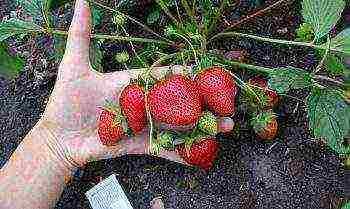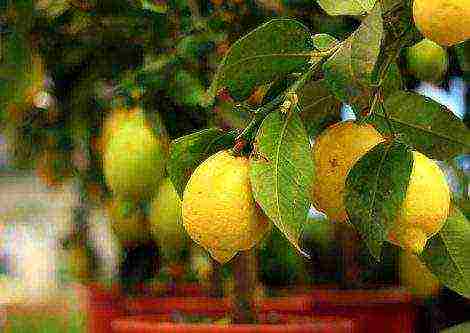Content
- 1 The names of the best early grape varieties
- 2 What are the types of wine
- 3 The best frost-resistant varieties
- 4 The best large varieties
- 5 The best black varieties
- 6 The best green varieties
- 7 The most productive varieties
- 8 Grapes Timur
- 9 Grape Elegant
- 10 Grape Kishmish-342
- 11 Grape Harold
- 12 Galahad grapes
- 13 Friendship grapes
- 14 Rizamat grape
- 15 Tason grapes
- 16 Gourmet grapes
- 17 Early Grape Red Muscat
- 18 Muscat Amber Grape
- 19 Grapes Fun
.
Many people mistakenly say that green grapes are used as a raw material for making the world famous Portuguese green wine. However, in fact, this wine is called green not by color, but by geography of production, and can be green, and pink, or red, depending on the composition and variety of grapes. As for the green grape berries, this is a variety of ordinary white grapes, which grows, including in the southern latitudes of our country, and is represented by both technical (for the production of wines and cognacs) and table (for fresh consumption) varieties.
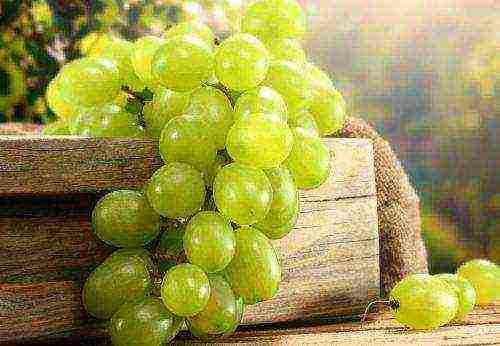
Valentina is one of the popular green grapes
Useful properties of green grapes
The composition of green grapes contains almost the same nutrients as in other varieties. True, it turned out that berries of light colors, in contrast to intensely colored ones, are poorer in antioxidants, but tannins, organic acids, vitamins and microelements in green berries are not less.
Two hundred grams of green grapes contain a quarter of the daily value of vitamin K, almost the same amount of copper, 15% potassium and vitamin C each, 10% are carbohydrates, tocopherol, magnesium, iron, manganese and dietary fiber and 5% - phosphorus, calcium and vitamin B1.
The pits and skins contain most of the phytonutrients, phenolic acids and flavonoids, and there are also many in the pulp and berry skins. Due to the presence of such a variety of nutrients, green grapes are indispensable for the nutrition of patients with disorders in the digestive system, as well as those at risk of cancer and cardiovascular diseases.
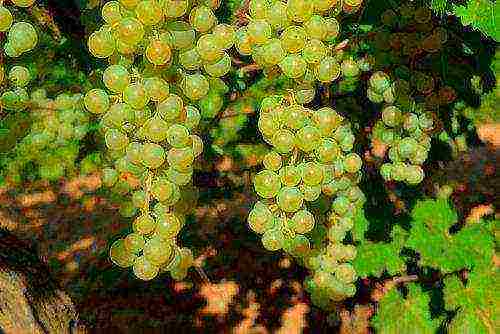
Albarinje grapes, like other green varieties, have a high nutritional value.
The most common varieties of green grapes
Light, including green grape varieties are more thermophilic, but recently there has been a noticeable expansion of green vine plantations towards the northern latitudes. Thanks to proper care, it is possible to grow green grapes of early maturing varieties there, which have time to ripen and collect a sufficient amount of sucrose before the start of the autumn rainy season. If we talk about the varieties most widespread throughout the territory of viticulture, then table grapes are represented by the following:
- Chasloy white;
- Husayna white (ladies' fingers);
- Oval kishmish and others.
Among the technical varieties, the most common are:
- Albarinier;
- White Muscat;
- Aligote;
- Riesling and others.
There are also universal varieties of green grapes that can be used both as table and for wine production: Albillo, Aurora and others.
All these varieties contain substances useful for the human body and necessary for winemaking, but some of them require special care, so it is worth dwelling on this issue in more detail.

Husayne grapes are white. also known as lady's finger
Varieties of green grapes and care features
Domestic winegrowers have long identified for themselves the most acceptable varieties of grapes in terms of cultivation and care with medium frost resistance, which allows them to preserve the vitality of the vine even in severe winter cold. Among the best varieties that are always popular with consumers, there are several varieties adapted to our latitudes.
White miracle
This truly marvelous grape belongs to the table hybrid varieties with low to medium vigor. The bunches of the White Miracle are extraordinary in size and can weigh up to 900 g.
The color of large oval berries is light green, amber when fully ripe and exposed to sunlight. The composition of the pulp is dense, fleshy, the taste is sweet, refreshing, the yield is consistently average.
The positive qualities of this variety are its unsurpassed taste and impeccable presentation, as well as the simultaneous ripening of berries on a bunch. The grapes are not afraid of transportation, they retain their fresh appearance for a long time.
The disadvantage is the fragility of annual shoots.
Leaving: planting grapes should be in warm, well-permeable soil, planting time - 2nd decade of April - end of May. The planting pit should be covered with a mixture, which includes humus, wood ash and sand in equal parts.
The established cuttings need to be provided with regular care:
- loosen the soil, destroy weeds;
- remove surface roots;
- carry out spring preventive treatment;
- water moderately;
- feed with fertilizers;
- tie up elongated shoots;
- be sure to provide winter shelter.
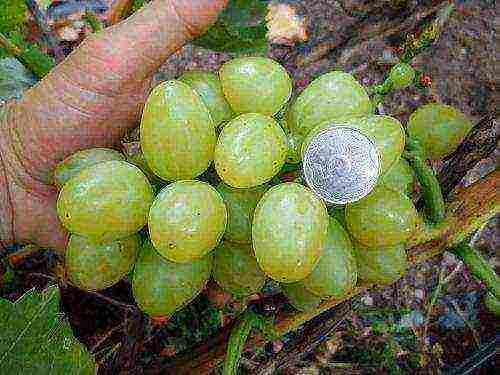
The White Miracle grape is an excellent table variety for sale
Chardonnay
The variety belongs to the technical variety of grapes and is the best for making white wine.
The cylindrical bunches consist of round, medium-sized, green-white berries with a thin but tough skin. The pulp is sweet, aromatic. The yield is low, the ripening period is 140 days.
In addition to the obvious advantages (unsurpassed taste and ideal composition for making high-quality wine), Chardonnay also has significant disadvantages:
- susceptibility to infection with mildew and powdery mildew;
- a tendency to decay;
- instability before spring frosts;
- tendency to "pea" (berries in a bunch become smaller "in peas").
Chardonnay remains the most favorite variety of winegrowers.
Care: plant better in stony or clay-lime soil, preferably on the western slopes. Recommended:
- application of nitrogen fertilizers in spring and organic and mineral fertilizers in early autumn;
- removal of shoots in order to avoid compaction of the crown;
- pruning leaving 10-12 eyes.
Usually, with proper care and favorable weather conditions, this variety does not show characteristic flaws.
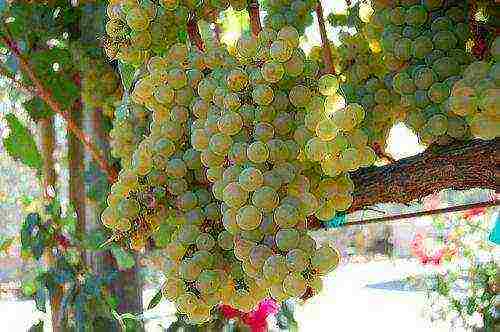
Chardonnay grapes love rocky soils
White Muscat
One of the oldest and most famous varieties with medium height and yield, used in technical viticulture.
Thanks to its excellent sugar accumulation and an indescribable flavor of citrus and tea rose, it is ideal for the production of white muscat wines.
Cylindrical medium dense bunch, berries are round, light green in color, the flesh is tender, melting in the mouth, juicy. Ripening period under favorable weather conditions and proper care is 140 days. Amazing taste is overshadowed by such disadvantages of grapes as:
- easy infection with gray mold, anthracnose and other diseases in wet weather;
- instability to attacks of phylloxera and spider mites;
- instability to frost.
Muscat is afraid of heavy clay soil, wet lowlands, it is preferable to plant it on the sunny side of the site. Additional care measures:
- thinning bushes, cutting out excess and damaged shoots;
- in order to increase productivity - artificial pollination, grafting.
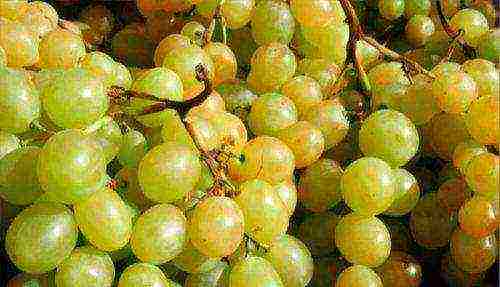
White Muscat grapes prefer sunny locations
Bazhena
The Bazhena variety belongs to the table hybrid vigorous varieties. It does not need additional pollination, it has a high yield and an early ripening period - only 100 days.
Conical and cylindrical, of medium density, the bunches consist of very large berries (weighing up to 15 g), elongated and light green in color. In full maturity, the berries acquire a salad and yellowish color, the pulp becomes fleshy, juicy, with a high sugar content in the composition. The berry taste is sweet with a delicate apple and cherry aftertaste.
The advantage of the variety is its high transportability and impeccable presentation, not to mention the taste and eye-pleasing color of the berries.
Given the significant disadvantage of the variety - low frost resistance, it needs to be provided with appropriate care:
- cover tightly for the winter so that the roots do not freeze;
- trim to 6-7 eyes;
- apply mineral and organic fertilizers for feeding;
- timely remove dried and weak shoots;
- carry out preventive treatment at least 2 times a season.
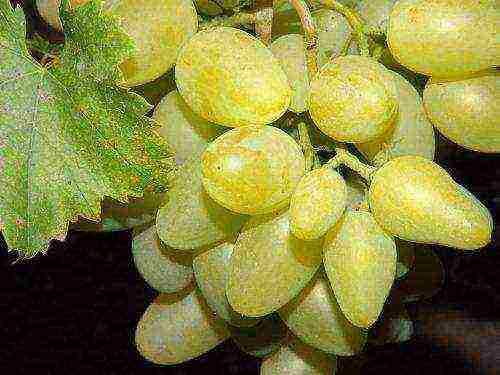
Bazhena grape is an attractive early variety
Valentine
A table grape with strong vigor, Valentina has many benefits. The bunch contains large, slightly oblong berries, first light green, and later amber yellow, which are not too tightly closed. The bunch, although loose, but rather weighty due to the length (sometimes up to 40 cm), the berries are not prone to "crumbling", the pulp is tender in composition, melting in the mouth, with a sage flavor, there are only 2 seeds in the berry.
The variety is characterized by a consistently high yield, resistance to gray rot and mildew, good transportability. If the advantages are obvious, then the disadvantages are the excessive tenderness of the skin, which bursts after heavy rains, and brown blotches on the surface of the berries, which many mistake for scab.
Caring for the Valentine variety does not differ in specialized features, except that pruning on this grape is carried out by a long method - leaving 8 eyes. All other care measures are practically the same as procedures for other varieties.
It has been established that the berries of green grape varieties are not as high in calories as varieties of intensely red and blue flowers, therefore, such grapes can be used in both medicinal and dietary nutrition.
Subscribe Be aware of new products on our site
When arranging the site, a separate area, well-lit by the sun, is allocated for the vineyard. The owners are faced with a difficult task - the choice of varieties that are available in agricultural technology and have an unsurpassed taste. This article discusses the very best grape varieties, broken down for ease of perception into separate categories. We will talk about names, tell you what they are and what characteristics they have.
The names of the best early grape varieties
Growing early grape varieties is economically beneficial. In addition, intensive maturation reduces the risk of damage to the bushes by various diseases or insects. The growing season lasts on average 95-115 days... Bunches are highly valued due to their taste and presentation, since rotting is extremely rare.
Veles
Veles has a beautiful bunch of pink berries up to 2 kg, and in some cases up to 3 kg. The grape has a pronounced nutmeg aroma.
The bushes are very tall. The plant tolerates frosts down to minus 21 °. Veles has good resistance to diseases and is rated with points above average.
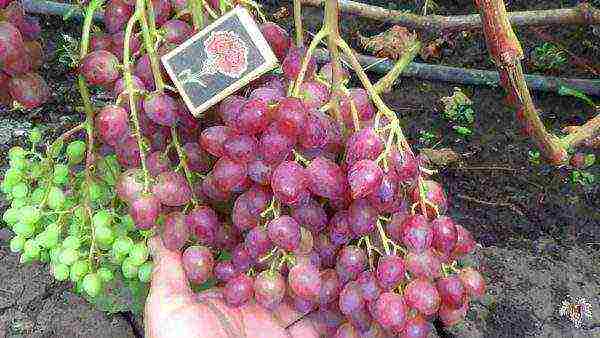 Bunch of grapes Veles
Bunch of grapes Veles
Adler
White grapes, which have the peculiarity of being well preserved for a month after ripening without loss of taste and aroma. Cylindrical clusters weigh up to 550-700 grams on average. The bushes have great vigor with a vigorous vine.
The plant shows resistance to typical grape diseases, frost resistance up to minus 24 °.
 Adler berry sizes
Adler berry sizes
Jupiter
Jupiter has cylindrical clusters with looseness. Fruits of reddish or purple color have an oval shape, weight is 4-6 grams, light nutmeg aroma. The vine is medium-sized, the plant's resistance to diseases is excellent. The grapes tolerate low temperatures down to minus 27 °.
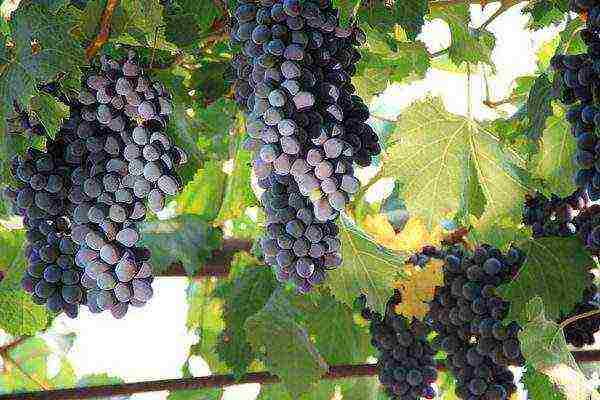 Bunches of jupiter on the vine
Bunches of jupiter on the vine
What are the types of wine
Technical (wine) grape varieties are most often characterized by vigorous bushes, small or medium-sized clusters in size and mass, and low productivity. However, the taste of the berries is distinguished by multifaceted notes and an interesting aroma.
A feature of the fruit is considered to be a high content of juice and a balance of sugar and acid.
Muscat
Muscat has a medium ripening period with a growing season of 125-140 days. The color of the berries is yellow with an amber tint. The brush covers up to 150 gr., But there are specimens up to 450 gr.
The fruits are very sweet, juicy with a medium skin density. The yield depends on climatic characteristics, ranging from 60 to 100 centners / ha. The culture is poorly resistant to typical grape diseases, especially with high humidity or prolonged rainfall.
 Wine variety Muscat
Wine variety Muscat
Chardonnay
The grapes are of medium ripening period, the growing season lasts 135-140 days. The brush is characterized by a cylindro-conical shape, looseness and medium density, the weight barely reaches 100 grams. The berry is colored green with a yellow tint, the skin is thin, the taste is sweet with a pleasant aroma... Chardonnay grows well on different types of soil, but the best results are noted on rocky and clay-limestone soils. Resistance to fungal diseases is low.
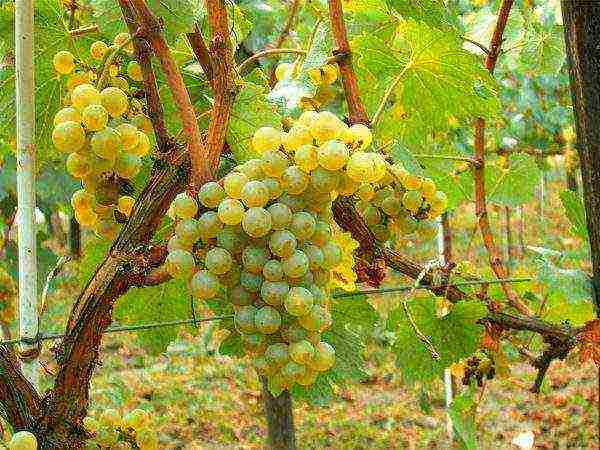 Bunch of Chardonnay
Bunch of Chardonnay
Sauvignon
Sauvignon is a French technical grape with a growing season of 130-135 days. Bushes have intensive growth, densely leafy. The cylindrical bunch is very dense, weighing 75-120 grams.
Rounded berries are yellow-green in color, and under the influence of direct sunlight they acquire a slightly yellow tint. Tolerant to mildew, but has a weak resistance to powdery mildew and gray rot. When the soil is waterlogged, the plant discards its inflorescences.
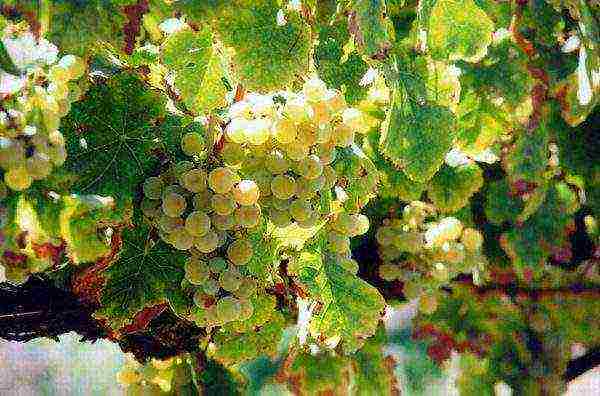 Sauvignon grapes are great for making white wine
Sauvignon grapes are great for making white wine
The best frost-resistant varieties
Grapes in this category have an average vine growth. Most of the frost-resistant representatives are technical varieties, but the berries can also be used for fresh consumption. The peculiarity of the taste of berries lies in the increased acidity and slight astringency. Some brainchildren of breeders are able to withstand forty-degree frosts without special shelter.
Lady fingers
Ladies' fingers is a high quality table grape. The growing season lasts 150-155 days, the vines are intensively formed. Narrow-conical clusters of large sizes with yellowish-green berries of an elongated shape, weight reaches 600-900 grams.
The pulp perfectly combines sugariness and refreshing sourness. Feature of the culture: weak resistance to diseases and pests, a long transition to fruiting in seedlings (clusters are formed only in the 5th year after planting).
 Everyone's favorite variety of ladies' fingers
Everyone's favorite variety of ladies' fingers
Aleshenkin
Fruits ripen early (120 days after bud formation). The bunches are large, I weigh an average of 1-2.7 kg. Oval berries are amber in color, very sweet and juicy. A feature of the Aleshenkin variety is the absence of seeds in half of the ripened fruits. The vine develops intensively, the grape sleeves bear fruit for 6-7 years.
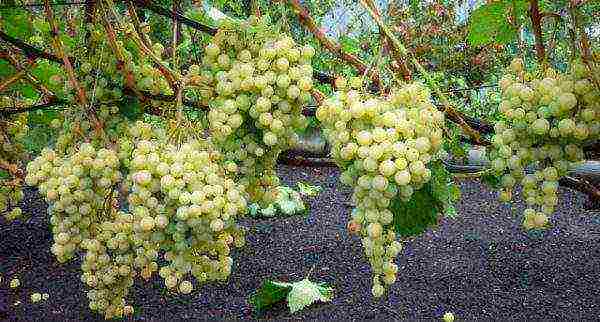 Aleshenkin grapes
Aleshenkin grapes
Lydia
The ripening time for lidia berries falls at the beginning of the autumn period. The pulp of the fruit is fragrant, very juicy. Ripe bunches have a characteristic pink color. The brush is loose, but reaches a large size, the average weight is 120-250 grams. The plant has strong immunity, which is manifested in high resistance to typical diseases.
 Popular grape variety Lydia
Popular grape variety Lydia
The best large varieties
Grapes with large fruits require careful attention. It is especially important to follow the rules of agricultural technology in order to prevent cracking of the berries. The most popular in this category are the following varieties.
Transformation
Table grapes are transformed with a ripening period of 110-125 days. The weight of a brush of a loose structure is 1.5 kg, but some specimens weigh up to 2.8 kg.
A tall bush with a strong root system and vines. Berries are large-fruited, elongated-oval pink.
The juice of the fruit accumulates a sufficient amount of sugar, but the sweetness is not felt when eating berries due to the slight sourness. Productivity - about 20 kg per bush.
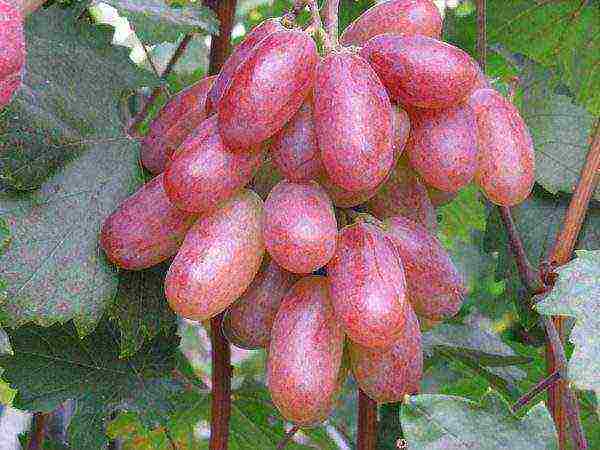 Large variety transformation
Large variety transformation
Lily of the valley
The ripening period of the lily of the valley variety is 125-135 days. The mass of the hand reaches 1.5 kg. The berries are oval, amber colored. There is a high resistance of the plant to diseases and pests, frost resistance up to minus 21 °, long-term storage of the crop.
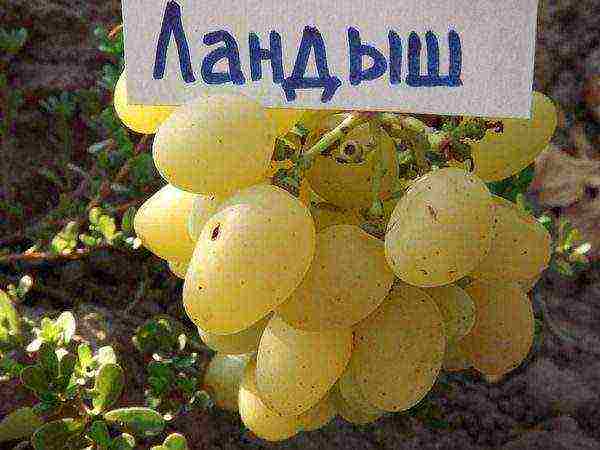 Giant lily of the valley
Giant lily of the valley
Century
Kishmish variety is a century old with a ripening period of 125-135 days. The bunches have a conical shape, the fruits are yellow-green, the weight of the brush is 800-1300 grams. Features of the culture: exquisite taste with a slight hint of nutmeg, high yield, frost resistance up to minus 23 ° and good disease resistance.
 Kishmish variety century
Kishmish variety century
Jupiter
Kishmish variety of medium early ripening. The average weight of the brush is 250 grams, the berries are large (up to 6 grams), painted in red or purple. The peculiarity of the variety is strong immunity and long shelf life.
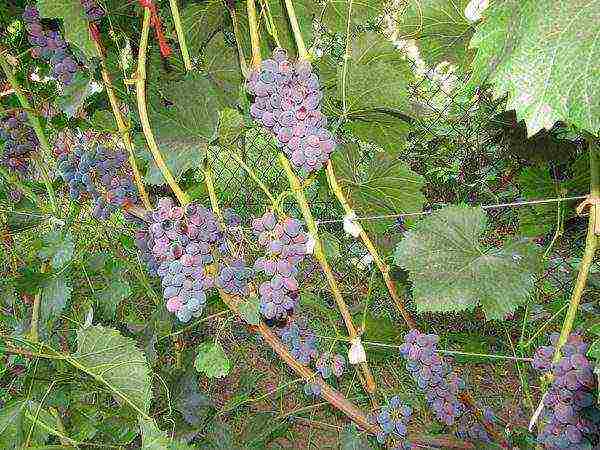 Ripening variety Jupiter
Ripening variety Jupiter
The best black varieties
Berries of black varieties contain a large amount of iron, selenium and zinc, which are of real value to the human body. Modern breeders spend a lot of time developing new dark hybrids with increased resistance to typical diseases and difficult climatic conditions.
Codryanka
Codryanka culture ripens early, is characterized by high marketability and taste, and is rightfully considered one of the best dark grape varieties. However, the plant requires careful care, otherwise the berries will begin to shrink. Also, the disadvantage is vulnerability to wasps, which spoil the presentation of the fruit.
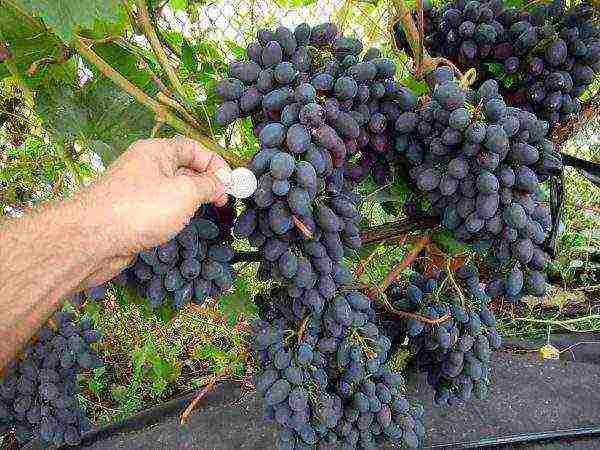 Codrianka is one of the best dark varieties
Codrianka is one of the best dark varieties
Kishmish Moldavian
The young shoot begins to bear fruit in the third year. The bushes are medium-sized with large clusters, reaching a mass of 190-250 grams. The growing season lasts 150-160 days. Features of the variety: high yield, high sugar content, long shelf life.
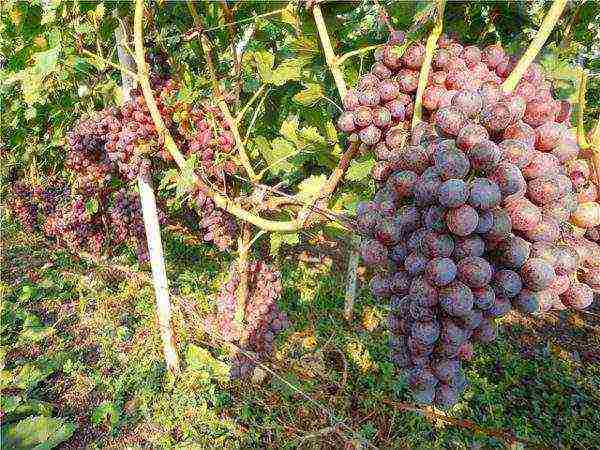 Kishmish Moldavian
Kishmish Moldavian
Delight is black
Very large clusters with round grapes adorn the vigorous bush. The growing season of the plant is 115-125 days. The variety is resistant to mildew and powdery mildew, but is affected by gray mold. Withstands frosts down to minus 25 °.
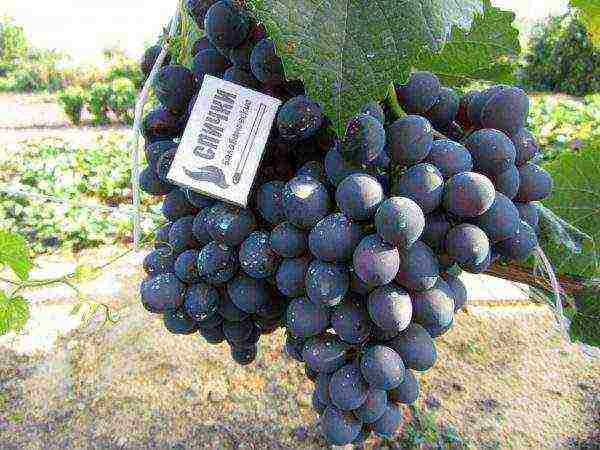 Sizes of berries of a variety of delight black
Sizes of berries of a variety of delight black
Athos
The hybrid was obtained as a result of crossing Codryanka and Talisman - favorites of varieties of different categories. Bunches have compact parameters, average density. The berries are characterized by an excellent taste that harmoniously combines sugar content and acidity. The plant is resistant to typical diseases and pests.
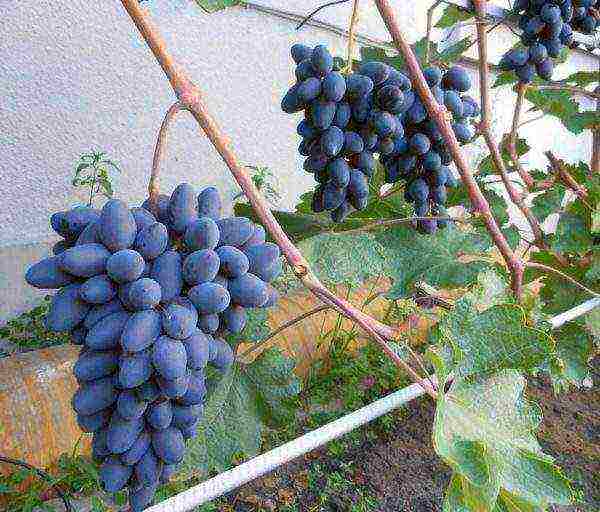 Bunches of atos variety
Bunches of atos variety
Kuban
Luxurious clusters with rounded large dark purple berries deliver a real aesthetic pleasure. The grapes have low disease resistance and require shelter for the winter.
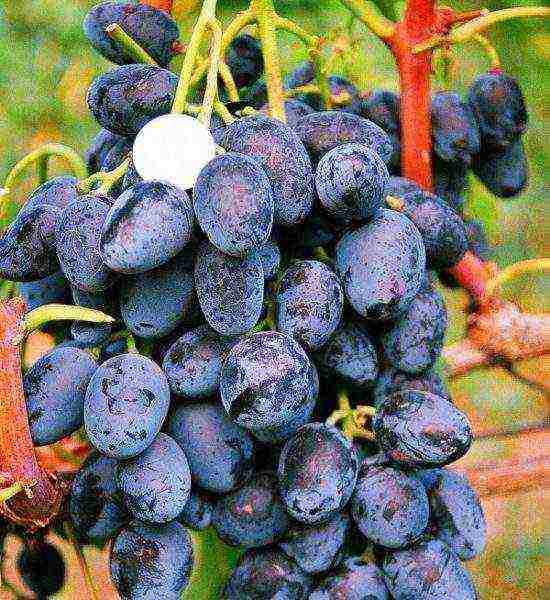 Kuban grapes close up
Kuban grapes close up
The best green varieties
Light grape varieties are thermophilic. Berries contain no less nutrients than intensely colored fruits (with the exception of antioxidants).Thanks to its usefulness and universal application, many growers want to acquire a cuttings of this category. Among the most popular technical varieties are the following:
- Chardonnay;
- White Muscat;
- Riesling;
- Aligote.
Popular table varieties:
- Lady fingers;
- Shasloy white;
- Kishmish is oval.
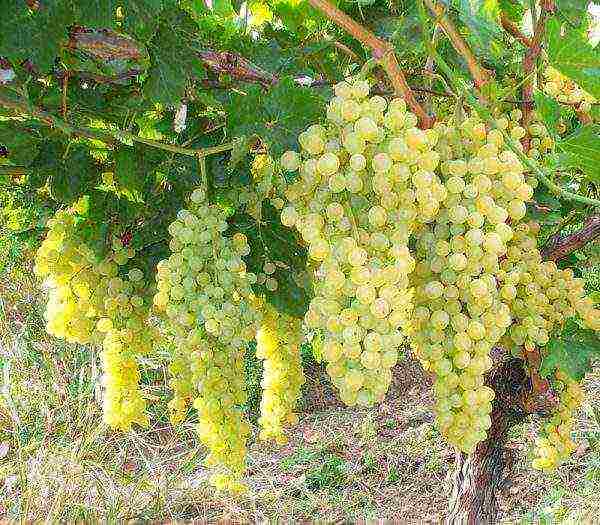 Shasloy white is an excellent table variety
Shasloy white is an excellent table variety
The most productive varieties
The fruitful varieties of grapes include table varieties. The bush has at least 70% of fruitful shoots, and the replacement buds are predominantly productive. Plants of this category are not highly resistant to frost, but they tolerate heat tolerably.
Matyash Janos
Technical ripeness occurs after 135 days. The bunches are medium in size, weighing 160-250 grams. The dark blue berry harmoniously combines sugar content and acidity. The plant is susceptible to mildew and gray rot, often affected by the leafworm, so prophylaxis is required.
 Bunch of mintas janos
Bunch of mintas janos
Khalili black
Early ripening black grapes (105-115 days). There is a strong growth of the bush and intensive development of the vine. A bunch of conical shape weighs up to 350-500 grams. Oval berries on a cluster adhere tightly to each other. The culture is susceptible to mildew and powdery mildew, poorly tolerates frost, requiring special shelter.
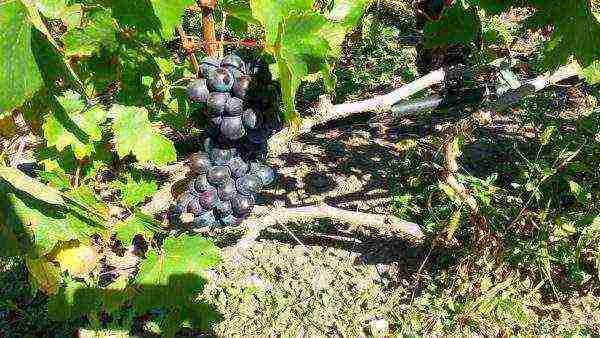 Khalili black variety on a bush
Khalili black variety on a bush
Cardinal
Cardinal plant with medium early ripening. The berry is dark blue and large in size. The mass of the brush reaches 360-580 grams. The potential of the crop is characterized by high productivity, but it is unstable, since climatic features and weather disasters have a great impact on the growing season. There is also a low resistance to typical diseases and pest attacks.
For the winter period, the bush must be covered.
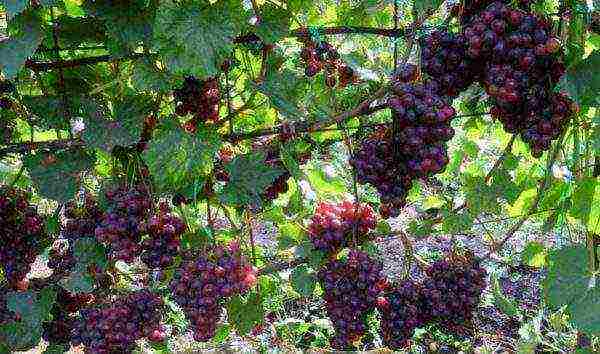 Cardinal's bush
Cardinal's bush
The variety of varieties and features of each species allows you to choose a plant that is most adapted to certain climatic conditions. And the taste qualities of the best representatives of their groups will satisfy the needs of any gourmet.
 Every grower wants the best grape varieties to be presented on his site, which would be unpretentious in care, disease-resistant, fruitful and always tasty. But with all diligence, due to the difference in climatic and weather conditions, the plans of the growers themselves and the size of the plot, it is hardly possible to make a universal list.
Every grower wants the best grape varieties to be presented on his site, which would be unpretentious in care, disease-resistant, fruitful and always tasty. But with all diligence, due to the difference in climatic and weather conditions, the plans of the growers themselves and the size of the plot, it is hardly possible to make a universal list.
If the berry is grown for own consumption, the best grape varieties are those that, when ripening at an early date, have the most interesting taste, high sugar content and aroma.
In this case, the transportability of the bunches and the record yield shown by technical varieties are not so important to the winegrower. After all, households prefer honey brushes weighing up to a kilogram to an abundance of tart berries.
Grapes Timur
 The variety of Russian selection, ripening in 105-110 days, was obtained by crossing the grapes Vostorg and Frumoasa Albe, and has established itself as early ripening and unpretentious. Timur grapes are table varieties and show an average growth force, therefore, when planted near vigorous plants, they can fall into their shade, which will affect the yield and quality of berries. The bushes tolerate frosts down to -25 ° C, rarely get infected with gray mold and downy mildew.
The variety of Russian selection, ripening in 105-110 days, was obtained by crossing the grapes Vostorg and Frumoasa Albe, and has established itself as early ripening and unpretentious. Timur grapes are table varieties and show an average growth force, therefore, when planted near vigorous plants, they can fall into their shade, which will affect the yield and quality of berries. The bushes tolerate frosts down to -25 ° C, rarely get infected with gray mold and downy mildew.
The plant shows the best results when grown on vigorous rootstocks and using both short and long pruning. On one shoot of grapes, on average, from 1.5 to 2 clusters are tied. A ripe bunch weighs up to 600 grams, has a conical shape and medium density.
When cultivating the best quality berries, it is possible to achieve if the soil under the vine is loose and light. On dense soils, the berries ripen longer and, with insufficient ripeness, appear herbaceous. The brush consists of large nipple-shaped berries up to 3 cm long and weighing 6 to 8 grams.Distinctive features of one of the best grape varieties are the pointed tip of a white or greenish berry and a beautiful amber tan that appears when fully ripe.
Timur grapes quickly accumulate sugar, its berries have a crispy dense pulp, balanced bright taste and aroma with a nutmeg hue.
Grape Elegant
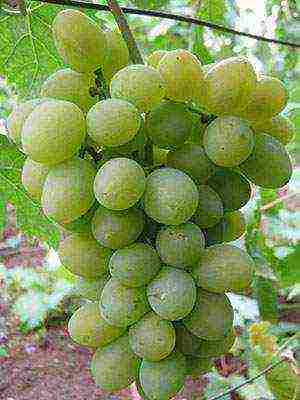 Bred as a result of crossing Frumoas Albe and Delight, the Elegant grape was obtained by Russian scientists and is rightfully recognized as one of the best among the early varieties. The period from the appearance of greenery to the ripening of berries lasts 110-115 days, while, if preventive treatments are carried out on time, the plant is resistant to mildew and gray mold infection. The plant can withstand winters with frosts down to –25 ° C and in a number of regions is grown without any problems without shelter, is well compatible with most of the rootstocks, is characterized by good ripening of shoots and a consistently high yield when pruned into 6–8 buds. A bunch of elegant grapes of medium size and weight up to 400 grams, has a conical or nearly cylindrical shape.
Bred as a result of crossing Frumoas Albe and Delight, the Elegant grape was obtained by Russian scientists and is rightfully recognized as one of the best among the early varieties. The period from the appearance of greenery to the ripening of berries lasts 110-115 days, while, if preventive treatments are carried out on time, the plant is resistant to mildew and gray mold infection. The plant can withstand winters with frosts down to –25 ° C and in a number of regions is grown without any problems without shelter, is well compatible with most of the rootstocks, is characterized by good ripening of shoots and a consistently high yield when pruned into 6–8 buds. A bunch of elegant grapes of medium size and weight up to 400 grams, has a conical or nearly cylindrical shape.
Despite the tendency to peas, Elegant deserves to be called one of the best grape varieties for personal consumption, since its berries weighing up to 7 grams have a crispy texture and a refreshing taste.
Ripe oval or nipple-shaped fruits contain up to 22% sugars. When filled, the greenish berry turns white and takes on a golden tan. The skin is thin, but this does not interfere with the storage of the brushes and their transportation.
Grapes Kishmish-342
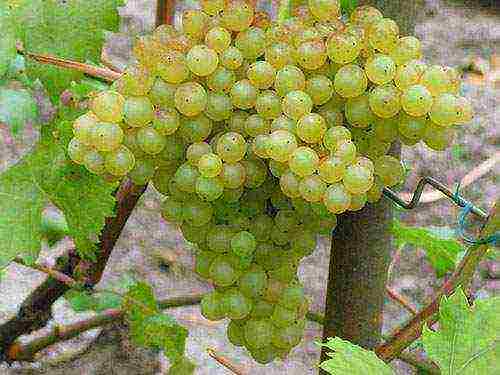 The well-known hybrid grape Kishmish-342 is of Hungarian origin and is obtained from crossing the Perlet and Villars blanc varieties. According to the maturity period, equal to 110-115 days, this variety also belongs to the early ones. The plant forms large, vigorous bushes, with well-ripening shoots, and also hibernates well at temperatures down to -26 ° C. Up to 80% of the shoots formed on Kishmish-342 or Kishmish Hungarian grapes bear fruit, which allows for high yields. Powerful perennial bushes are capable of producing very large clusters. The average weight of brushes is 300–500 grams.
The well-known hybrid grape Kishmish-342 is of Hungarian origin and is obtained from crossing the Perlet and Villars blanc varieties. According to the maturity period, equal to 110-115 days, this variety also belongs to the early ones. The plant forms large, vigorous bushes, with well-ripening shoots, and also hibernates well at temperatures down to -26 ° C. Up to 80% of the shoots formed on Kishmish-342 or Kishmish Hungarian grapes bear fruit, which allows for high yields. Powerful perennial bushes are capable of producing very large clusters. The average weight of brushes is 300–500 grams.
Kishmish forms round or ovoid berries up to 1.7 cm in diameter and weighing about 3.5 grams. The color of ripe fruits is greenish or yellow-golden, the pulp is sleepy, which does not contain seeds and their rudiments.
For the absence of seeds, high yield and excellent taste, Kishmish No. 342 is recognized as one of the best grape varieties for personal consumption and can be used both fresh and for making high-quality raisins.
Grape Harold
In the south of Russia, the domestic grape variety Harold matures in 95-100 days and is considered one of the earliest.
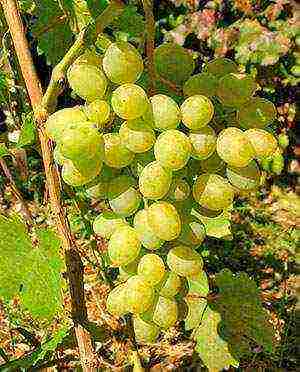 At the same time, a vigorous plant shows good resistance to the most common diseases, but requires mandatory normalization at the flowering stage so that the bushes are not overloaded with crops, and the shoots have time to ripen by the end of the growing season. Three-quarters of the resulting shoots begin to bear fruit.
At the same time, a vigorous plant shows good resistance to the most common diseases, but requires mandatory normalization at the flowering stage so that the bushes are not overloaded with crops, and the shoots have time to ripen by the end of the growing season. Three-quarters of the resulting shoots begin to bear fruit.
As they ripen, the bunches reach a weight of 400-500 grams and consist of oval yellowish-amber berries about 2.5 cm long and weighing about 6 grams. As a contender for the title of the best variety, Harold grapes exhibit excellent taste. It has a pleasant juicy texture, a harmoniously sweet taste and a pronounced nutmeg aroma.
Galahad grapes
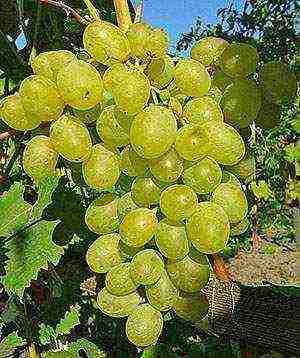 The early table grapes Galahad, obtained from the crossing of the descendants of Talisman and Vostora with the Muscat Vostorg variety, in the Kuban conditions ripens by August, that is, in 95-100 days. The plant is distinguished by a high growth rate, good frost resistance down to –25 ° C, as well as resistance to infection by powdery mildew, powdery mildew and gray rot. Shoots of Galahad grapes ripen well during the season, and fruiting begins at 60–75% of the growth.
The early table grapes Galahad, obtained from the crossing of the descendants of Talisman and Vostora with the Muscat Vostorg variety, in the Kuban conditions ripens by August, that is, in 95-100 days. The plant is distinguished by a high growth rate, good frost resistance down to –25 ° C, as well as resistance to infection by powdery mildew, powdery mildew and gray rot. Shoots of Galahad grapes ripen well during the season, and fruiting begins at 60–75% of the growth.
Like many of the best grape varieties for personal consumption, Galahad produces cylindrical or conical clusters weighing between 600 and 1100 grams. The density of the bunches is average, the brushes can be transported without damage. Heavy, weighing up to 12 grams, oval berries quickly accumulate sugar. When ripe, they acquire a beautiful amber color, while the pulp remains firm and aromatic.
Among the descendants of Rapture, the Galahad grapes stand out for their very high taste and deserve 8.9 points on the expert rating scale.
Friendship grapes
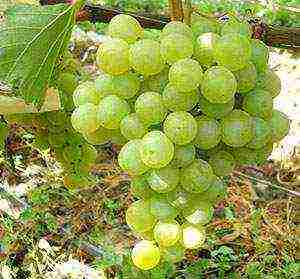 The Druzhba variety is included in the list of the best grape varieties due to the combination of early ripeness of berries, increased resistance to diseases and rare versatility. In areas where viticulture is developed in Russia, Druzhba grapes ripen in the second half of August. In winters, when the temperature does not drop below –23 ° C, the bushes practically do not freeze. In summer, grapes yield up to 180 centners of berries per hectare.
The Druzhba variety is included in the list of the best grape varieties due to the combination of early ripeness of berries, increased resistance to diseases and rare versatility. In areas where viticulture is developed in Russia, Druzhba grapes ripen in the second half of August. In winters, when the temperature does not drop below –23 ° C, the bushes practically do not freeze. In summer, grapes yield up to 180 centners of berries per hectare.
Conical brushes of medium size and density ripening on the vine can be intended both for consumption in the form of fresh berries, and for the production of juices and high-quality low-alcohol drinks. Druzhba grapes have white rounded berries up to 2.4 cm in diameter and weighing 4 grams. The consistency of the berries is juicy, dense, with a characteristic aroma of nutmeg.
Rizamat grape
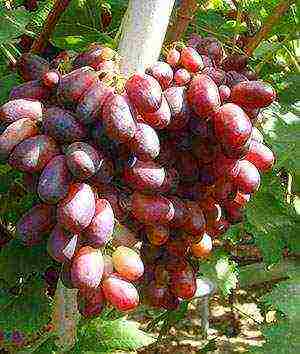 The Rizamat grape bred by breeders of Uzbekistan is the result of crossing the Parkent and Katta-Kurgan varieties. Ripening in early or medium terms, the variety was named after the famous winegrower in the southern country and has established itself as a high-yielding variety. Up to 250 quintals of high quality sweet berries are obtained from a hectare of these grapes, used both fresh and in the form of raisins.
The Rizamat grape bred by breeders of Uzbekistan is the result of crossing the Parkent and Katta-Kurgan varieties. Ripening in early or medium terms, the variety was named after the famous winegrower in the southern country and has established itself as a high-yielding variety. Up to 250 quintals of high quality sweet berries are obtained from a hectare of these grapes, used both fresh and in the form of raisins.
Since the variety is of southern origin, in the conditions of Russia, the bush can freeze, and the resistance in powdery mildew of the variety is low.
When caring for plants, it should be borne in mind that the shoots of Rizomat grapes do not pinch, and the quality of the berries can be affected by a lack or excess of moisture. The stepsons on the bushes, in order to avoid overload, are removed, and the ripened brushes are promptly removed. With proper care, the variety produces very large branched bunches, strewn with berries weighing up to 14 grams. The pink berries of one of the best grape varieties have a pronounced cylindrical shape and are covered with a waxy coating.
Tason grapes
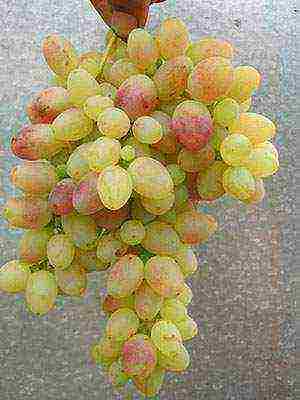 The table grape variety Tason, which ripens in 100-110 days, was obtained by domestic breeders from the crossing of grapes Italy and the variety Zoreva. Plants of this early-maturing variety have good vigor, the shoots on them mostly ripen by autumn, and more than half of them are fruitful.
The table grape variety Tason, which ripens in 100-110 days, was obtained by domestic breeders from the crossing of grapes Italy and the variety Zoreva. Plants of this early-maturing variety have good vigor, the shoots on them mostly ripen by autumn, and more than half of them are fruitful.
Rightfully considered to be the best grape variety for personal consumption, Tason rooted well and is compatible with common rootstocks.
For the variety, pruning for 10-12 buds is recommended, while the bushes can withstand up to 40 shoots. Compared to other varieties, Tason grapes are not very hardy. Plants can withstand frosts of the order of -22 ° C, and also do not have sufficient resistance to the causative agents of powdery mildew and mildew. But due to the short ripening period, the disease does not often affect fruiting plants.
A characteristic feature of the variety is large brushes weighing up to 1200 grams, consisting of white-pink oval berries with dense pulp and decent taste. The average berry weight is 7 grams, the length is up to 2.5 cm.
Gourmet grapes
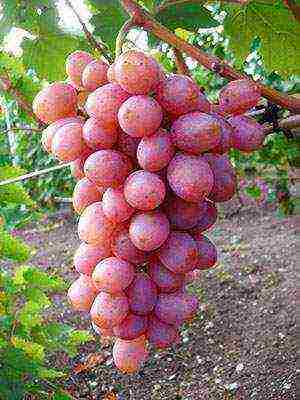 Medium-sized bushes of Gourmet grapes, bred by V.N. Krainov, when crossing the Kishmish Luchisty and Talisman varieties, gives ripe clusters 110–120 days after the appearance of the first leaves. The hybrid form is distinguished by good ripening of shoots and rooting of planted cuttings. Ray indicators for grapes were recorded when pruning up to 8 eyes with up to 35 shoots on the bush.
Medium-sized bushes of Gourmet grapes, bred by V.N. Krainov, when crossing the Kishmish Luchisty and Talisman varieties, gives ripe clusters 110–120 days after the appearance of the first leaves. The hybrid form is distinguished by good ripening of shoots and rooting of planted cuttings. Ray indicators for grapes were recorded when pruning up to 8 eyes with up to 35 shoots on the bush.
Frost resistance of Gourmet grapes reaches -23 ° C, the bushes are well resistant to infection with the main diseases of the culture and give consistently high yields of good quality.
A bunch of these early grapes can weigh between 500 grams and 1.3 kg. And oblong pink berries of an attractive appearance and weighing about 9 grams have a pleasant pulp density and a harmonious dessert taste with a complementary nutmeg hue.
Early Grape Red Muscat
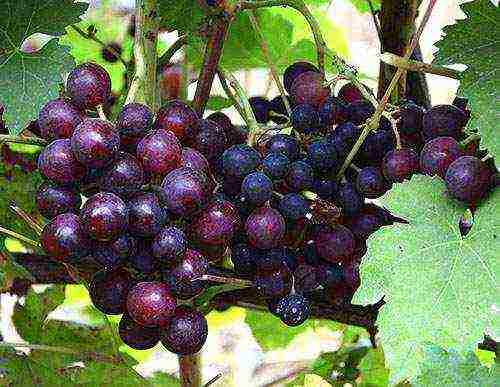 The grapes are fully consistent with their name and ripen after 95-100 days from the beginning of the growing season. Early Red Muscat - grapes that form medium to vigorous bushes with quality ripening shoots and excellent compatibility with existing rootstocks. When pruned by 6–8 buds, the bushes cope with the load of 35–50 eyes. However, due to the low cold resistance, the grapes can withstand temperatures down to -23 ° C, it is better to cover the variety for the winter.
The grapes are fully consistent with their name and ripen after 95-100 days from the beginning of the growing season. Early Red Muscat - grapes that form medium to vigorous bushes with quality ripening shoots and excellent compatibility with existing rootstocks. When pruned by 6–8 buds, the bushes cope with the load of 35–50 eyes. However, due to the low cold resistance, the grapes can withstand temperatures down to -23 ° C, it is better to cover the variety for the winter.
The superearly red Muscat grape shows medium to high resistance to common diseases.
As the perennial vines grow, develop and accumulate, the bushes form larger, heavy clusters. The average weight of a moderately dense or loose cylindrical bunch is 300-400 grams. The berries are round or oval with a diameter of 1.8 cm and weighing about 5 grams have a rich burgundy-red color, which darkens, becoming purple by the time of ripening.
As befits one of the best varieties, the grapes have a crispy texture and good taste with little acidity. A variety with decent table qualities almost does not suffer from wasps, brushes can be transported and stored on the vine for up to 60 days.
Muscat Amber Grape
 From the opening of the buds on the Muscat Amber grape to the full ripening of the berries, it takes from 105 to 115 days, therefore the variety is classified as a medium early species. The variety forms bushes of medium strength, on which up to 90% of the annual growth ripens. Due to frost damage stronger than -20 ° C, the plants are grown as a covering crop. The variety is susceptible to mildew and powdery mildew infections. But it tolerates fluctuations in humidity, the berries rarely crack or begin to rot.
From the opening of the buds on the Muscat Amber grape to the full ripening of the berries, it takes from 105 to 115 days, therefore the variety is classified as a medium early species. The variety forms bushes of medium strength, on which up to 90% of the annual growth ripens. Due to frost damage stronger than -20 ° C, the plants are grown as a covering crop. The variety is susceptible to mildew and powdery mildew infections. But it tolerates fluctuations in humidity, the berries rarely crack or begin to rot.
Muscat Amber grapes are characterized by medium-sized conical or cylindrical clusters of medium density. The bunch can weigh about 350 grams, and the rounded berries that make up it can weigh up to 2.7 grams. The brushes are easy to carry. Ripe berries with fleshy juicy pulp, excellent taste and aroma of nutmeg are covered with dense green or light amber skin.
Grapes Fun
The basis for the work of Ukrainian breeders in the creation of Zabava grapes was the Kodryanka and Laura varieties, well known for their high taste, yield and early maturity.
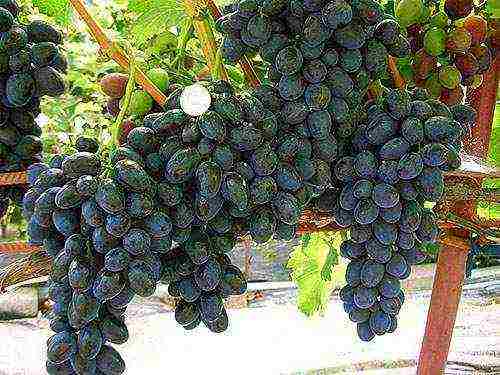 The hybrid form obtained from them is also distinguished by an early maturity. The berries ripen within 100-110 days from the beginning of the growing season. The plant takes root well, matures, hibernates and resists infections no worse than the parent varieties
The hybrid form obtained from them is also distinguished by an early maturity. The berries ripen within 100-110 days from the beginning of the growing season. The plant takes root well, matures, hibernates and resists infections no worse than the parent varieties
Zabava grapes form large clusters of moderate density, consisting of 10-gram oval or egg-shaped berries of a dark blue color. Due to the thick waxy coating, full-weight clusters appear gray. The consistency of ripe berries is dense, the taste is bright and harmonious. The peel of medium thickness is not felt when fresh fruits are consumed, but protects the berries from spoilage by wasps and during transportation.
Rare and best grape varieties - video
There are super early, early, mid and late grape varieties. Each of them has its own characteristics. Of course, early and super early varieties are in greatest demand. Their berries are poured in four months or less. The article will describe the most common early grape varieties, their characteristics, taste.
Description of white and green early grape varieties
- "Timur" ripens by 104-116 days. Bunches of 600 g, not dense, conical. The berries are elongated, pointed at the end. Straw-white color.The grapes are crispy, sweet with nutmeg. Withstands up to -26 degrees and almost never gets sick.
- "Laura" refers to early grape varieties, ripens in 110-115 days. The shape of the brush is conical, loose, weighing 1 kg or more. The berry (9 g) is oval-round, light green. It is always marked with a layer of "wax" and may have an orange tan from the sun. The flesh is pleasant, and the bones are large. It tolerates frosts down to -23 degrees, is resistant to diseases and tolerates transportation well over long distances.
- "Augustine" gives an early harvest, already by 115 days from the beginning of the season. The brushes are small, up to 500 g, not dense. The berry is also small - 5.8 g, green-yellow. Very resistant to low temperatures. Can survive even at -30 without insulation. Unpretentious look, gives a stable, large yield. If it is not possible to immediately collect the bunches, they can be stored on the vine for up to 1 month without losing their taste and external qualities.
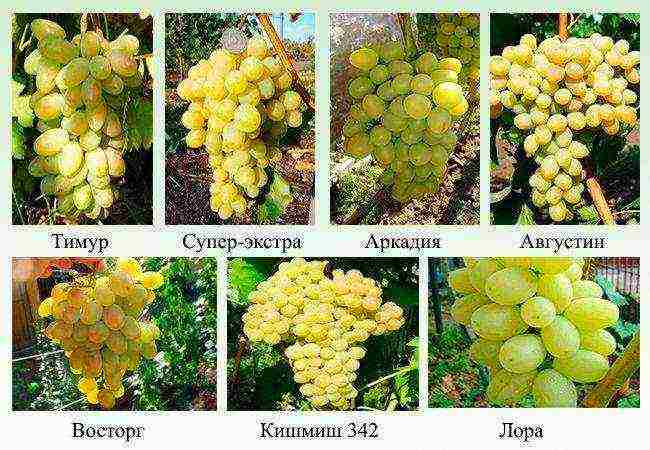 White and green early grape varieties
White and green early grape varieties - "Delight" belongs to one of the most common early grape varieties - the first bunches ripen 4 months after the appearance of foliage. The shape of the bunch is conical, dense, weight up to 2 kg. Berries (7.3 g) are straw-white, rounded, may have golden barrels from the sun. The pulp is sweet, crunchy, the skin is not tough. Withstands frosts down to -26 degrees.
- "Kishmish 342" ripens within 4 months. The grape weighs up to 3.5 g, oval, yellow-green, seedless. The bunches are large, up to 500 g one piece, loose, have a cylindrical shape. The plant tolerates frosts down to -26 degrees.
- "Arcadia" gives the first ready-to-eat fruits by 125 days from the day the leaves appear. The bunches are dense, conical, and can weigh up to 2 kg. The berries are huge - 15 g one piece, blunt conical shape. The color is green-yellow. It tolerates frosts down to -21 degrees, it is resistant to transportation and diseases.
- "Super extra" will sing for 125 days. Small brushes within 500 g. Berries 7 g, oval. The color is straw-whitish. The taste is simple. The disadvantages include rough skin. Withstands up to -29 degrees of frost.
Pink and red varieties
- "Julian" - an early grape variety yields a harvest 95 days after the appearance of the leaves. Huge clusters are of medium friability. The berries are oval or rounded, bright pink. The peel is not perceptible when chewing, the taste is sweet, crunchy. Resistant to frost down to -24 degrees. It can be transported over long distances due to its immunity to most diseases. It deteriorates slowly.
- "Victor" belongs to very early varieties. You can get grapes of this type in 100-110 days from the appearance of the leaves. A bunch in the shape of a cylinder. The color is bright pink with a purple tint after full maturity, but can break even when it reaches a yellow-pink color. Frost tolerates up to -30. Not afraid of fungal diseases. A demanding culture, it grows only on fertile soil - fertilizers are required at different periods.
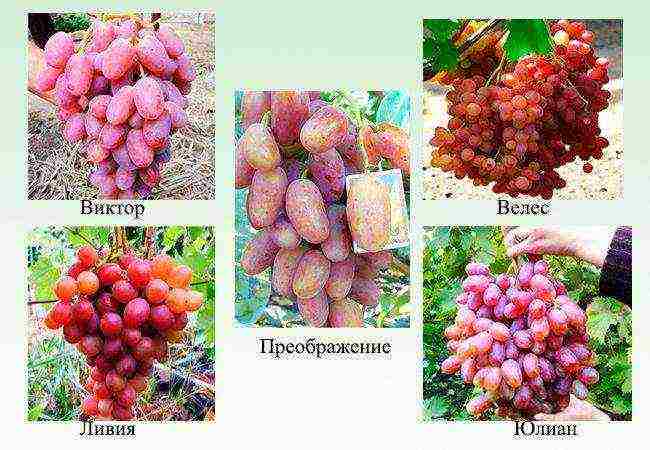 Pink and red early grape varieties
Pink and red early grape varieties - "Veles" can be consumed 105 days after the leaves bloom. The bunches are large, the berries are oval. Very tasty, has a bright pink color. Recommended for raw food consumption. It can survive at no more than -21 degrees, but additional insulation is desirable.
- "Libya" can ripen at 110 days. The brush is elongated, not dense. The berries are ovoid, reddish-purple in color. Gives off a nutmeg aroma, sweet, juicy. Pitted, but easy to separate, edible skin, not tough. Withstands frosts down to -21 degrees, and is stored in a cool place for no more than 33 days.
- "Transfiguration" ripens 115-120 days. It grows as a large bush, so it is best to shape its appearance, otherwise it will grow on the floor of the garden. The bunch is of different shapes, medium density and weighs up to 1.5 kg. The berries are slightly elongated (15 g) pink-red. It is a juicy and sweet look. It can withstand frosts down to -15 degrees, it can be stored for no more than a week.
What blue and black grapes are early ripening? 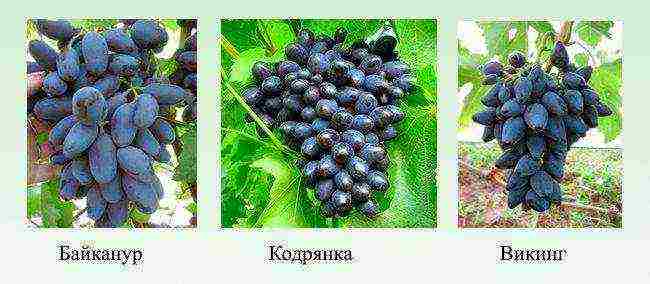 Blue and black early grape varieties 1
Blue and black early grape varieties 1
- "Kodryanka" very popular. This early grape variety, with proper care, yields a harvest 96-110 days from the day the first leaves appear. The brush weighs up to 600 g (record - 1.5 kg). The berry can weigh about 8 g - large, elongated blue-violet. Gives a stable high yield from year to year. Withstands frosts down to -22 degrees. Of the shortcomings, a tendency to peas is noted. The taste is pleasant, dry, does not deteriorate from hanging on the plant for a long time.
- "Viking" ripens 100-115 days from the appearance of the kidneys. The bunches are clearly conical. The berries are black-indigo, elongated and pointed on one side. Temperature up to -21 degrees will endure calmly, rarely gets sick.
- "Baikonur" yields a harvest 100-115 days from the day of budding. Grozi up to 1 kg, have a dark purple color. Elongated berries - 11.7 g. Very tasty, the skin can be eaten. Frosts at -28 are not terrible for him, as are most diseases. Resistant to transportation.
 Early blue and black grapes
Early blue and black grapes - "Charlie" ("Anthracite"), with proper care, will yield 105 days after the start of plant development. Bunches of 700-800 grams. The grapes are about 7 grams, dark, almost charcoal in color. Has no tendency to pea. Not afraid of frosts down to -28 degrees.
- "Glad" ripens in 115 days. The bunch is not dense, weighing 800 grams. The berries are large, 8 grams long each. Indigo or closer to black. Differs in juiciness, very aromatic. At a temperature of -21 or more, it may die. Stored and transported without problems, resistant to many diseases.
- "Buffet" can ripen from 115 to 125 days, depending on the conditions of detention. The bunches are dense, large up to 800 grams. The berries are very large, oval, weighing 12 grams. The taste is excellent, the skin is not tough. Frosts at -22 are well tolerated, rarely gets sick.
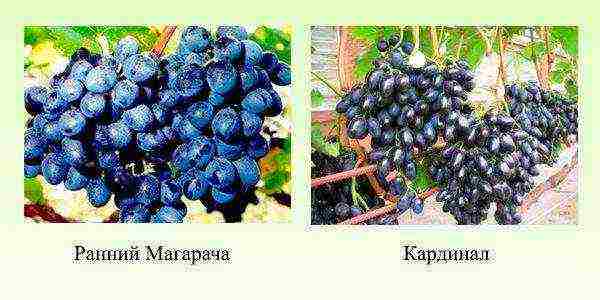 Blue and black early grape varieties 3
Blue and black early grape varieties 3 - "Early Magaracha" Is a tasty but capricious early grape variety. Ready to use for 4 months from the appearance of the kidneys. Brushes of 500 g, and fruits of 4 grams. The color is blue-black, but there is a rather thick layer of white "wax", the taste is normal, has 2-3 seeds. The juice turns out to be pink-red. Frosts below -20 degrees are fatal. It can often get sick, especially with a lack of feeding.
- "Cardinal" ripens 4 months. The bunch weighs up to 500 grams, not dense. Grapes (11 g) are round. The color is red-violet - more dark, with a touch. In grapes up to 4 seeds. The taste is delicate, sweet can give off the aroma of nutmeg. Among the shortcomings, it is worth mentioning the tendency to disease, peas, the instability of the crop, the fear of even small frosts.

